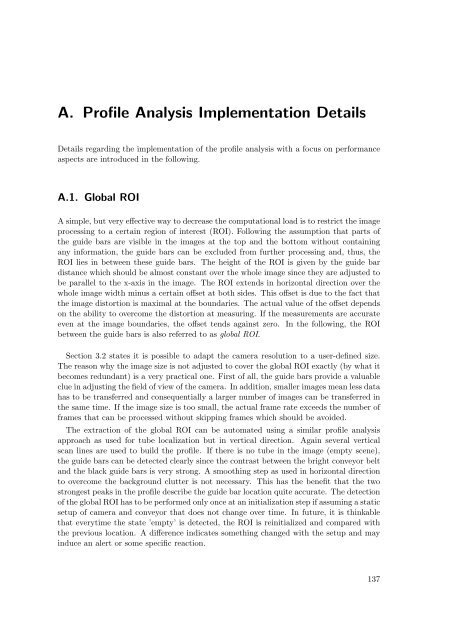Master Thesis - Fachbereich Informatik
Master Thesis - Fachbereich Informatik
Master Thesis - Fachbereich Informatik
Create successful ePaper yourself
Turn your PDF publications into a flip-book with our unique Google optimized e-Paper software.
A. Profile Analysis Implementation Details<br />
Details regarding the implementation of the profile analysis with a focus on performance<br />
aspects are introduced in the following.<br />
A.1. Global ROI<br />
A simple, but very effective way to decrease the computational load is to restrict the image<br />
processing to a certain region of interest (ROI). Following the assumption that parts of<br />
the guide bars are visible in the images at the top and the bottom without containing<br />
any information, the guide bars can be excluded from further processing and, thus, the<br />
ROI lies in between these guide bars. The height of the ROI is given by the guide bar<br />
distance which should be almost constant over the whole image since they are adjusted to<br />
be parallel to the x-axis in the image. The ROI extends in horizontal direction over the<br />
whole image width minus a certain offset at both sides. This offset is due to the fact that<br />
the image distortion is maximal at the boundaries. The actual value of the offset depends<br />
on the ability to overcome the distortion at measuring. If the measurements are accurate<br />
even at the image boundaries, the offset tends against zero. In the following, the ROI<br />
betweentheguidebarsisalsoreferredtoasglobal ROI.<br />
Section 3.2 states it is possible to adapt the camera resolution to a user-defined size.<br />
The reason why the image size is not adjusted to cover the global ROI exactly (by what it<br />
becomes redundant) is a very practical one. First of all, the guide bars provide a valuable<br />
clue in adjusting the field of view of the camera. In addition, smaller images mean less data<br />
has to be transferred and consequentially a larger number of images can be transferred in<br />
the same time. If the image size is too small, the actual frame rate exceeds the number of<br />
frames that can be processed without skipping frames which should be avoided.<br />
The extraction of the global ROI can be automated using a similar profile analysis<br />
approach as used for tube localization but in vertical direction. Again several vertical<br />
scan lines are used to build the profile. If there is no tube in the image (empty scene),<br />
the guide bars can be detected clearly since the contrast between the bright conveyor belt<br />
and the black guide bars is very strong. A smoothing step as used in horizontal direction<br />
to overcome the background clutter is not necessary. This has the benefit that the two<br />
strongest peaks in the profile describe the guide bar location quite accurate. The detection<br />
of the global ROI has to be performed only once at an initialization step if assuming a static<br />
setup of camera and conveyor that does not change over time. In future, it is thinkable<br />
that everytime the state ’empty’ is detected, the ROI is reinitialized and compared with<br />
the previous location. A difference indicates something changed with the setup and may<br />
induce an alert or some specific reaction.<br />
137














